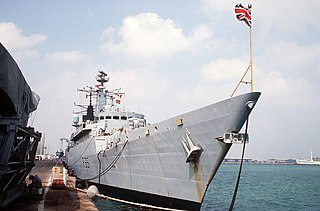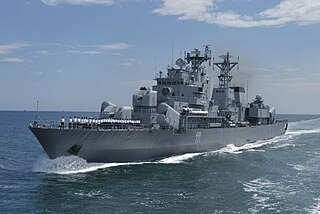Ferdinand I or Fernando I may refer to:
Fifteen ships of the Royal Navy have been named HMS Enterprise while another was planned:
Six ships of the Royal Navy have been named HMS Edinburgh, for the Scottish city of Edinburgh. In addition, one ship of the Royal Navy has carried the similar name HMS Duke of Edinburgh.

HMS London was a Type 22 frigate of the Royal Navy, originally named Bloodhound but renamed London at the request of the Lord Mayor of London.

Regele Ferdinand (F221) is a Type 22 frigate of the Romanian Naval Forces, formerly a Royal Navy ship named HMS Coventry. She was originally intended to be named Boadicea but was named Coventry in honour of the previous Coventry, a Type 42 destroyer sunk in the Falklands War. Following service in the Royal Navy she was sold to the Romanian Navy in 2003.
Thirteen ships of the British Royal Navy have been named HMS Surprise or HMS Surprize, including:
Nine Royal Navy ships have borne the name HMS Ambuscade:

The Romanian Navy is the navy branch of the Romanian Armed Forces; it operates in the Black Sea and on the Danube. It traces its history back to 1860.
Several ships of the Royal Navy have borne the name HMS Forth, after the River Forth:

Mărășești is a frigate currently serving with the Romanian Navy, named after Mărășești, the site of a Romanian victory in World War I. She was also named after her World War II namesake, just like the other two frigates of the Romanian Navy, Regele Ferdinand and Regina Maria, which use the names of the two World War II-era Regele Ferdinand-class destroyers. Mărășești served as the flagship of the navy between 1985 and 2004, when Regele Ferdinand became the new flagship. She is the largest warship of the Romanian Navy ever built in Romania.
Six ships of the Royal Navy have borne the name HMS Trent, after the River Trent:

The Regele Ferdinand class was a pair of destroyers built in Italy for the Romanian Navy during the late 1920s. The sister ships were the most modern and powerful warships of the Axis powers in the Black Sea during World War II. During the war they participated in the 1941 Raid on Constanța and the 1944 evacuation of the Crimea, although they spent the vast majority of the war escorting convoys in the Black Sea. The Romanians claimed that they sank two submarines during the war, but Soviet records do not confirm their claims. Following King Michael's Coup, where Romania switched sides and joined the Allies in late 1944, the two ships were seized and incorporated into the Soviet Black Sea Fleet. They were returned to Romania in 1951 and served until 1961 when they were scrapped.

The Battle of Jibrieni was an attack on 17 December 1941 by a Soviet submarine on an Axis convoy and its Romanian escorts off the coast of the Romanian village of Jibrieni. The engagement ended with the sinking of the attacking Soviet submarine M-59.
The Romanian Navy during World War II was the main Axis naval force in the Black Sea campaigns and fought against the Soviet Union's Black Sea Fleet from 1941 to 1944. Operations consisted mainly of mine warfare, but there were also escort missions and localized naval engagements. The largest naval action fought by the Romanian Navy was the 26 June 1941 Raid on Constanța, and its most extensive operation was the 1944 evacuation of the Crimea.

NMS Mărăști was one of four Vifor-class destroyers ordered by Romania shortly before the beginning of the First World War from Italy. All four sister ships were requisitioned when Italy joined the war in 1915. Originally named Vijelie by the Romanians, she was renamed Sparviero in Italian service. Not completed until mid-1917, the ship engaged Austro-Hungarian ships in the Adriatic Sea only twice before the war ended in November 1918. She was given a new name as Mărăști when she was re-purchased by the Romanians in 1920.

NMS Mărășești was one of four Vifor-class destroyers ordered by Romania shortly before the beginning of the First World War from Italy. All four sister ships were requisitioned when Italy joined the war in 1915. Originally named Vârtej by the Romanians, she was renamed Nibbio in Italian service. Not completed until mid-1918, the ship engaged Austro-Hungarian ships in the Adriatic Sea only once before the war ended in November. She was renamed Mărășești when she was re-purchased by the Romanians in 1920.

NMS Regele Ferdinand was the lead ship of her class of two destroyers built in Italy for the Romanian Navy in the late 1920s. After the Axis invasion of the Soviet Union on 22 June 1941, she was limited to escort duties in the western half of the Black Sea during the war by the powerful Soviet Black Sea Fleet which heavily outnumbered Axis naval forces in the Black Sea. The ship may have sunk two Soviet submarines during the war. In early 1944 the Soviets were able to cut off and surround the port of Sevastopol on the Crimean Peninsula. Regele Ferdinand covered convoys evacuating Axis troops from Sevastopol and was badly damaged in May when she rescued some troops herself.

NMS Regina Maria was the second and last of the two Regele Ferdinand-class destroyers built in Italy for the Romanian Navy in the late 1920s. After the Axis invasion of the Soviet Union on 22 June 1941, she took part in the Raid on Constanța a few days later and may have damaged a Soviet destroyer leader during the battle. The powerful Soviet Black Sea Fleet heavily outnumbered Axis naval forces in the Black Sea and the Romanian destroyers were limited to escort duties in the western half of the Black Sea during the war. In early 1944 the Soviets were able to cut off and surround the port of Sevastopol on the Crimean Peninsula. Regina Maria covered convoys evacuating Axis troops from Sevastopol in May and rescued several hundred herself.
Regina Maria was the name of at least two ships of the Romanian Navy and may refer to:

NMS Regele Carol I was a passenger ship of the Romanian Maritime Service and later a warship of the Romanian Navy, serving as both minelayer and seaplane tender. She was completed and commissioned in 1898 and sunk in 1941, during World War II.
This page is based on this
Wikipedia article Text is available under the
CC BY-SA 4.0 license; additional terms may apply.
Images, videos and audio are available under their respective licenses.









